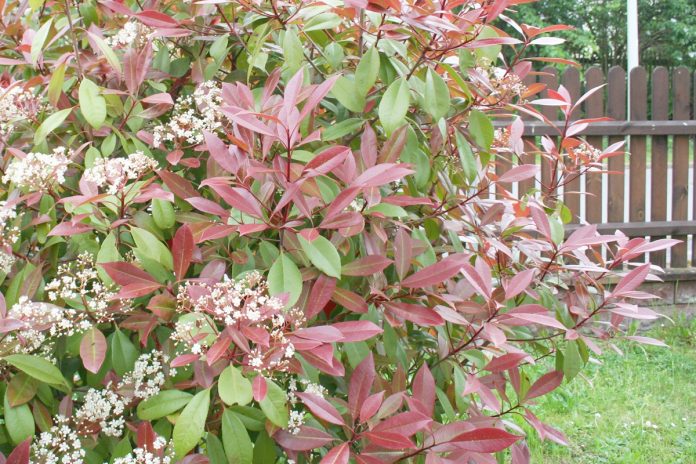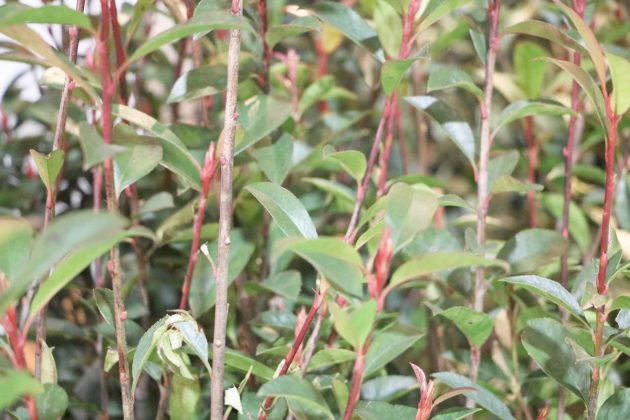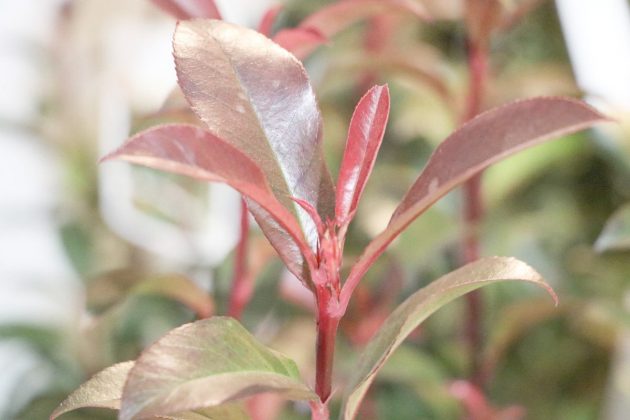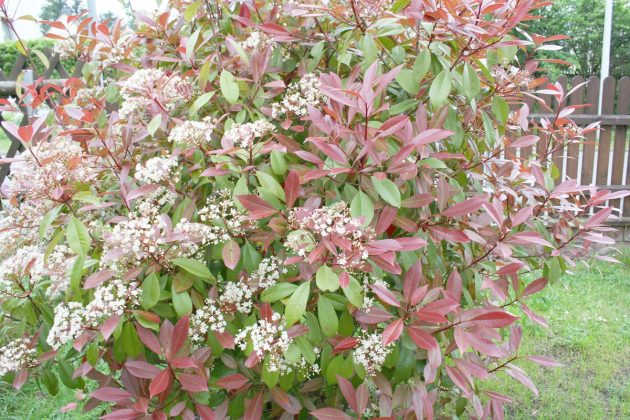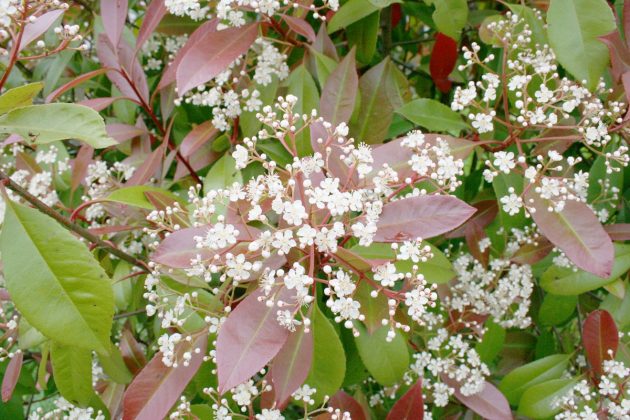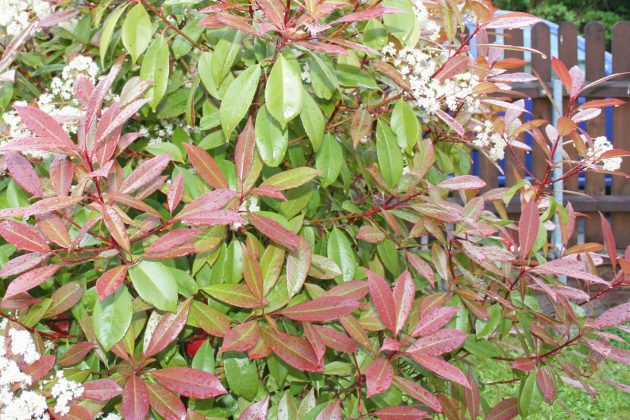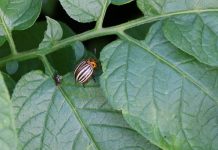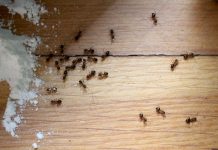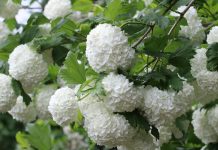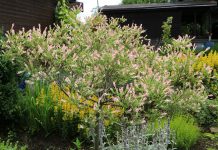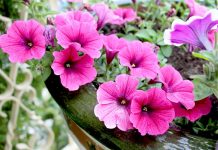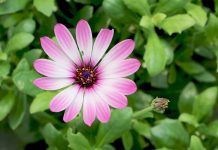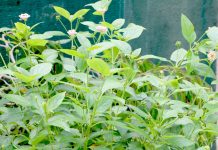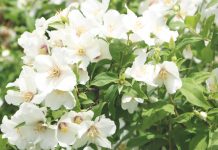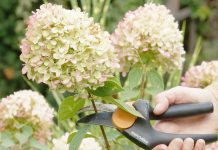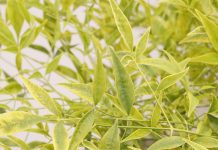With its bright red leaf shoots and white panicles the photinia steals the show from traditional ornamental trees. The highlight within the varietal family is called Photinia fraseri Red Robin and scores with its undemanding nature. This applies especially to winter-mild areas that do not afflict this flowering and fruit-bearing plant too much. This guide for caring and cutting practically puts all details in a nutshell.
Plant Profile
Contents
- plant family: Rose family (Rosaceae)
- sub-tribe: Stone fruit (Pyrinae)
- name of genus: Photinia
- native in Asia, mainly in China
- popular hybrid: Red Robin (Photinia fraseri)
- evergreen shrub or small tree
- plant height of 200 to 350 cm
- elliptical, glossy green leaves with red shoots
- white panicles from May to June
- small red berry fruits in autumn
With its bright red leaf shoots the photinia offers a passionate plea for modern accents of garden designs in spring. At the latest when this ornamental plant wears its white dress of flowers and holds globular berry fruits, we fall under its charm.
The floral jewel within the multi-faceted family has the striking name Photinia fraseri Red Robin and inspires as both decorative hedges and picturesque standard solitaire. Read here to which care this flowering and fruit-bearing plant attaches importance and how to cut it.
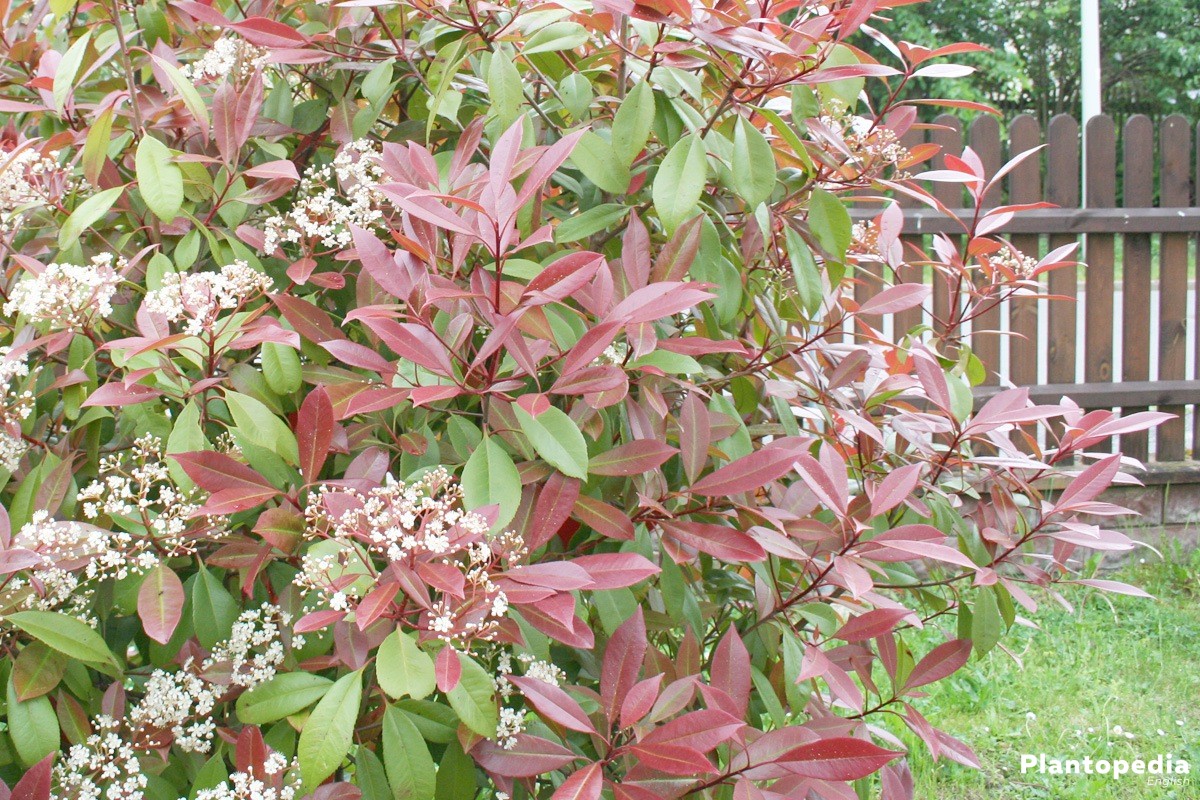
The apple-shaped, 4-5 mm small fruits remain on the Photinia until long in winter and are a coveted food for birds. The slightly poisonous berries are not suitable for consumption.
Care
In the canon of the professional care of a Photina, all the following aspects are of equivalent relevance. It is the prudent combination of the ideal location, a balanced supply with water and nutrients as well as a skilful cutback, that guarantees a magnificent Red Robin, as it is in the books. As the following guide shows, the implementation of the individual actions does not present any noteworthy challenges for gardening beginners.
Location
In order for a Photinia to present itself from its most beautiful side, the location has to be chosen with care. The plant originates from distant lands, and is therefore not naturally designed for winter-like locations. The further north your garden is, the more protected the location should be.
These criteria are important:
- sunny to off-sun area
- ideally a little shady when there is bright winter sunshine
- warm and protected against strong winds
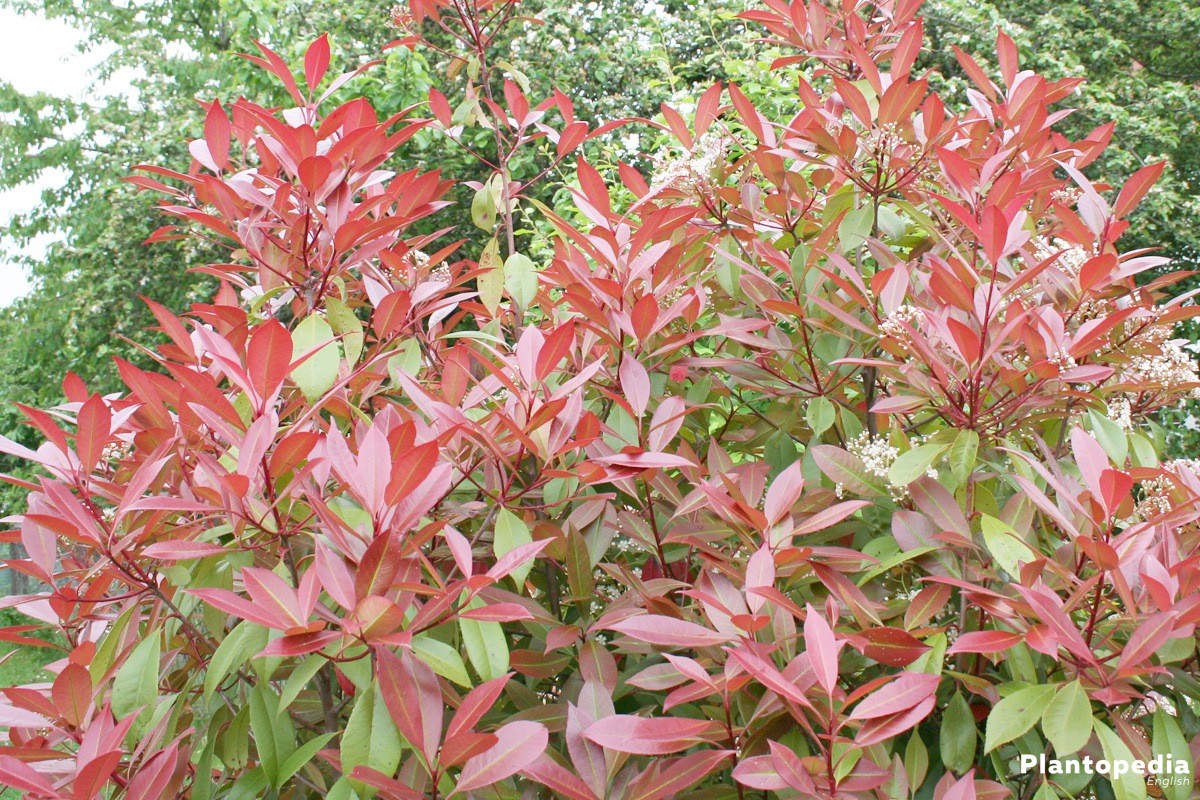
At a half-shady location, the shrub grows as well. Due to the absence of adequate exposure to sun, however, the brightness of the leaves leave something to be desired.
Soil
Equipped with a flat root system, Red Robin is dependent on a soil with these characteristics for a vital growth.
- deep and well drained
- fresh to moderately dry
- nutrient-rich and humus-free
In case that the soil does not reach the optimum, add adequate soil aids. Too firm, clay-soaked soil receives a first-class permeability when adding 30 to 40 percent sand. The structure of sandy soil can be improved by adding standard soil or compost. On the other hand, peat is only conditionally suitable as an additive. Although it loosens the soil at short notice, it causes a condensation and reduces the capacity to store water in the long run.
Watering
Photinia fraseri favours a damped substrate with intermediate drying. This way, there will not be waterlogging which would put an early end to the flowering shrubbery. Adjust the watering frequency to the current weather, to receive a proper water balance. At a young age the magnificent shrubs like Red Robin demand more moisture. An adult plant, on the other hand, is well rooted, so additional pouring is less frequently required.
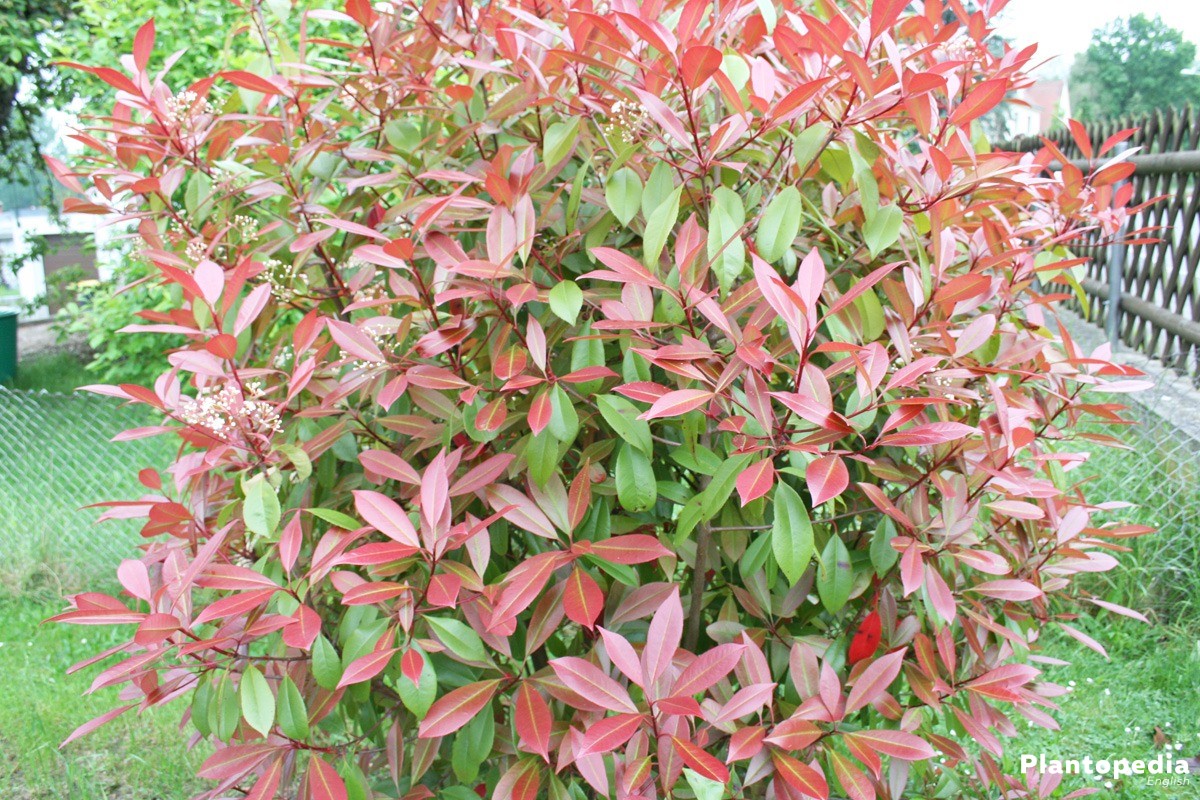
This is how to do it right:
- within the first week after planting, pour regularly and plentifully, without causing waterlogging
- after that, do not water until the surface of the soil has dried about 2-3 cm deep
- pour the root slice with normal tap water successively until no more water is absorbed
When cultivating in pots, you will have to use the watering can more often. The sunnier the location, the faster the soil will dry out. On warm summer days, please check daily, whether the substrate is dried. Pour with a thin steam until the first drops run into the saucer. Please keep in mind that evergreen plants lose water from their leaves throughout the year. This is why you have to pour a photinia fraseri even in winter on frost-free days.
Fertilising
If a photinia was able to speak up to this aspect of cultivation, it would wish for an organic nutrient supply. Natural fertilisers, such as compost, bark humus, horse dung or horn shavings gradually enter the plant pathways, as they have to be prepared by soil organisms beforehand. On the other hand, the concentrated quantum of mineral complete fertiliser is more intense, but decreases rapidly, so the long-term effect that you hoped for is ultimately lost.
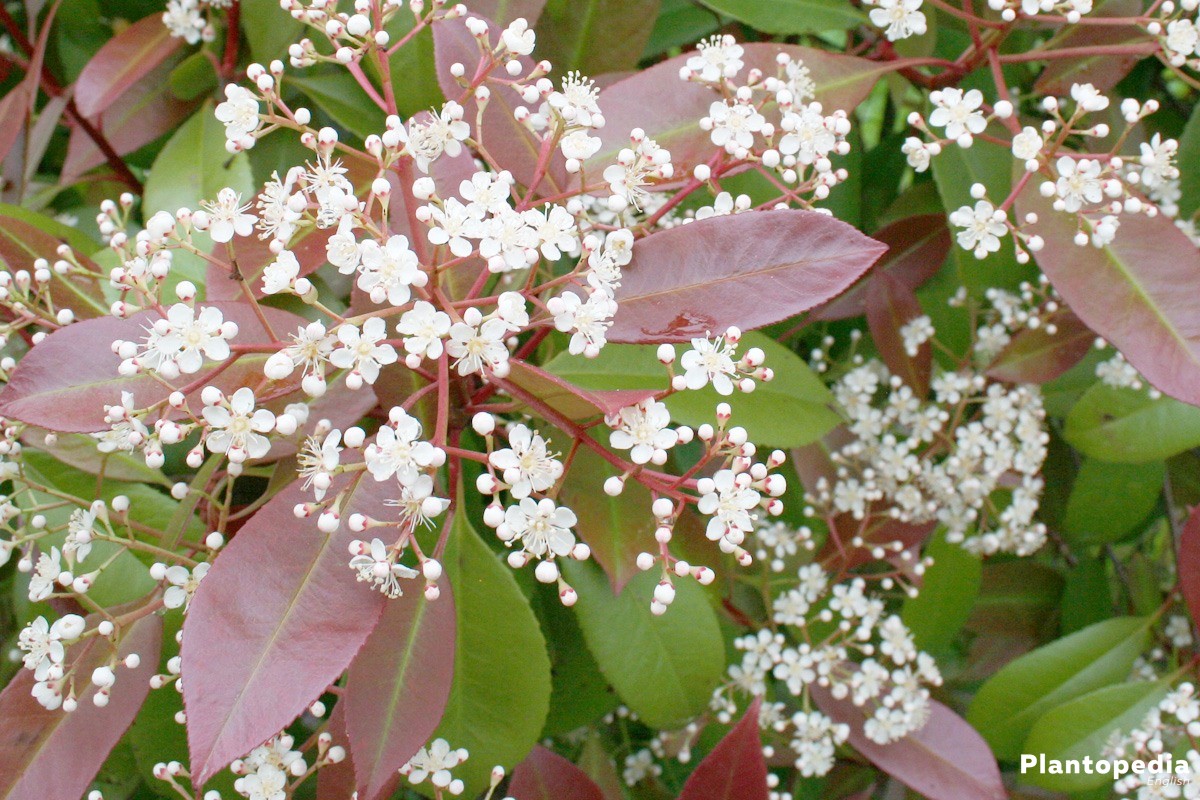
This is how to fertilise your Red Robin skilfully:
- from the beginning of March to the end of July fertilise every 2-3 weeks using compost, horn shavings or barkhumus
- between August and early September fertilise twice with potassium-rich comfrey manure to support hardiness
- stop nutrient supply in the middle of September
Attach the organic material only to the surface with a rake to avoid damaging the flat root system. Then water. Switching to a potassium fertiliser in autumn is mainly useful because it strengthens the cell walls and lowers the freezing point or the cell sap. In case that you have no access to comfrey manure, specialist shops with potassium magnesium or azet-vital-potassium provide you with adequate alternatives.
Overwintering
One of the mainstays of a competent cultivation of photinias, such as Red Robin, is a careful winter protection. From its entire constitution, the shrub is only merely hard. Especially the beautiful red leaf shoots in early spring are threatened by late frost. The more exposed the location, the more important are the following precautions for healthy wintering.
- before the first frost, thickly cover the root slice with foliage, compost, straw or brushwood
- envelop the shoots with a breathable cover of gunny sacks or garden fleece
- protect high trees from the winter sun using bast mats or framed brushwood
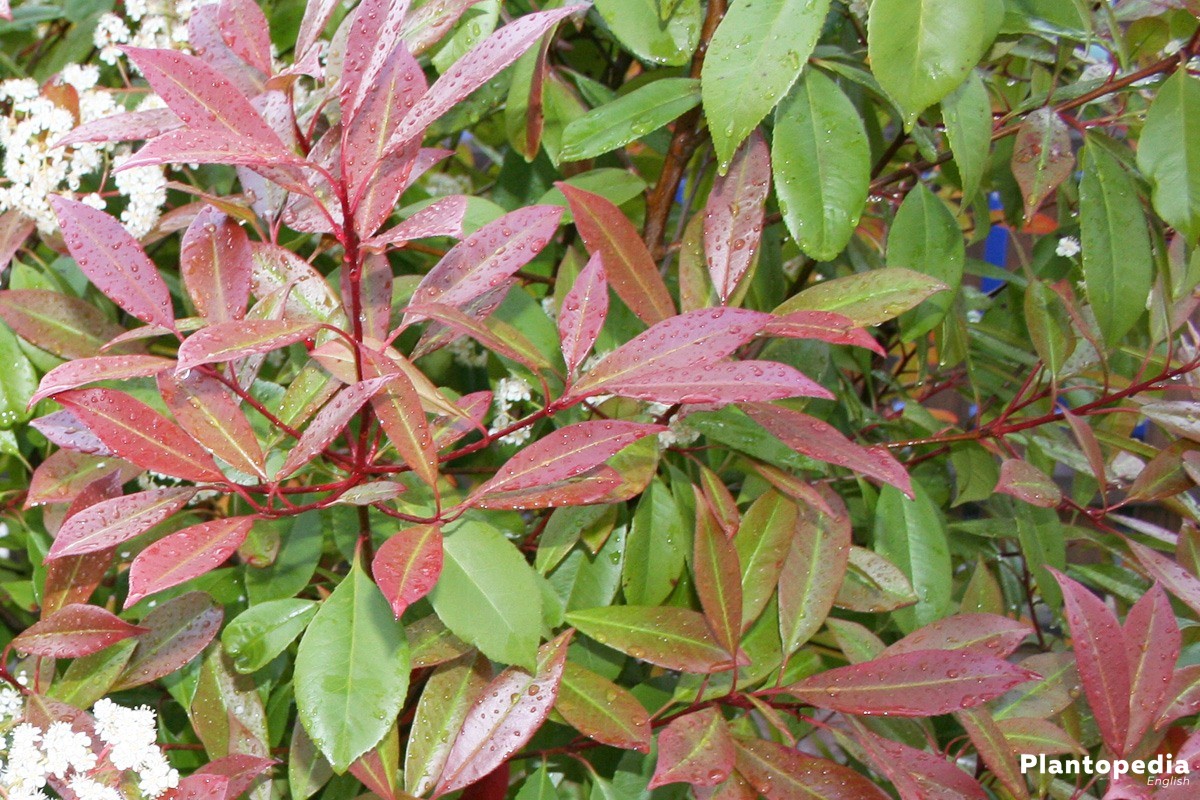
If a photinia grows in a pot, put it in a light, frost-free place in winter. In the open, even the thickest coat can hardly prevent a complete failure.
Cutting
Without a cutback, the plant height will increase rapidly, so a photinia fraseri Red Robin reaches a majestic 400 cm within a short time, with an equally impressive width of up to 300 cm. It is true that this process is to the expense of a densely leaved, compact habit, since this ornamental wood grows bare from below and from the inside.
An annual cutback prevents this undesirable development. The excellent tolerability of this rose to cutting is beneficial to you, since a photinia keeps reliably growing even from old wood.
- only thin the shrub, respectively the crown, in January/February
- the best time for a contour cut is at the end of the flowering period in June/July
- shorten all branches by a maximum of one third
- place the clean, ground scissors shortly near an outward-facing bud
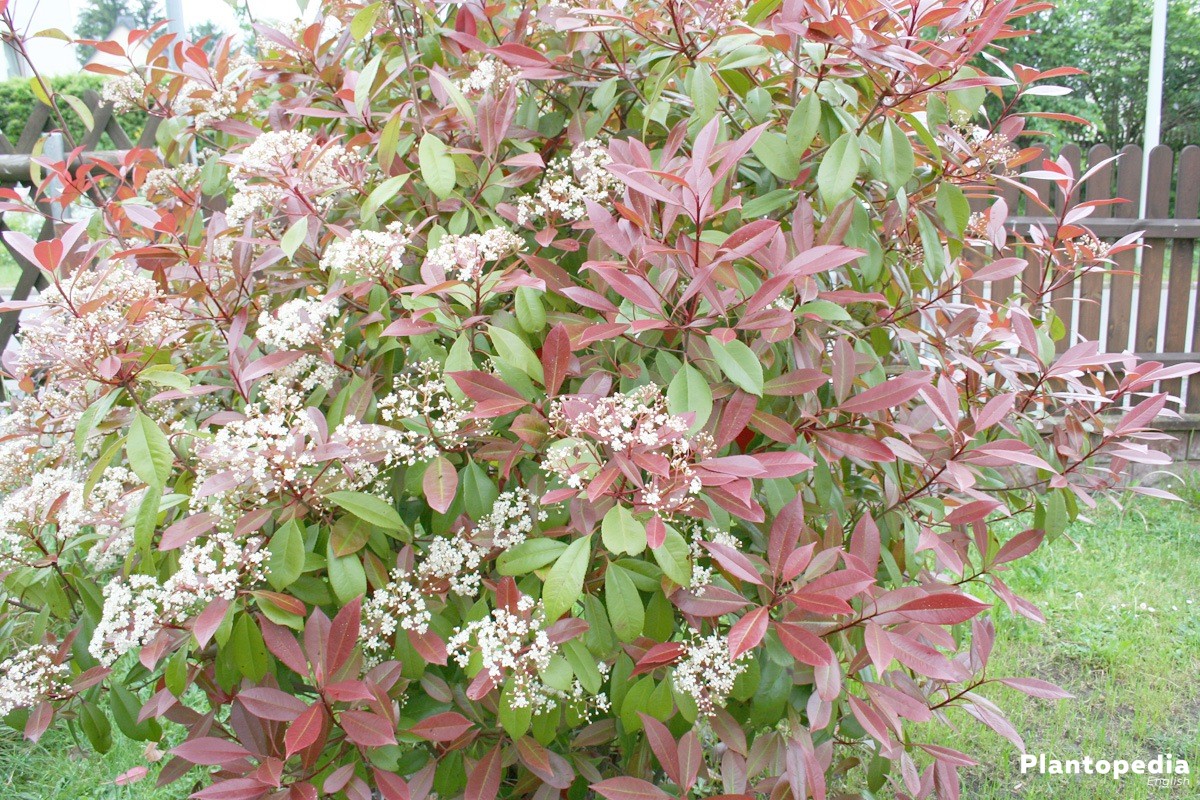
The more faded flowers remain on a photinia, the more luxuriant the autumnal amount of fruits. The bright red berries put joyous colours in the dreary garden until well into the winter. In addition, the birds are happy about this vitamin-rich food.
Hedge cut
Its robustness to trimming in combination with the colourful appearance, has encouraged creative gardeners to prefer the photinia as a hedge plant in contrast to classics like cherry laurel. In order to preserve the flowering shrub as a decorative design element and opaque, evergreen wall, these particularities have to be taken care of for a correct cut.
- cut a photinia-hedge in a trapezoid shape
- a wide base narrows upward, so that sunlight reaches all branches
- cords tensioned between wooden posts can be used as a help
- angled or rounded edges improve the light inside the hedge
A petrol-driven or electric hedge trimmer is only suitable for very large hedges. Sure, the work is done quickly when using mechanical support, but it leaves a dishevelled appearance since it tears many leaves into pieces. You can counteract this damage by cutting parallel to the shrub down from the tip. It would be better to use a manual hedge trimmer, in order to control every single cut.
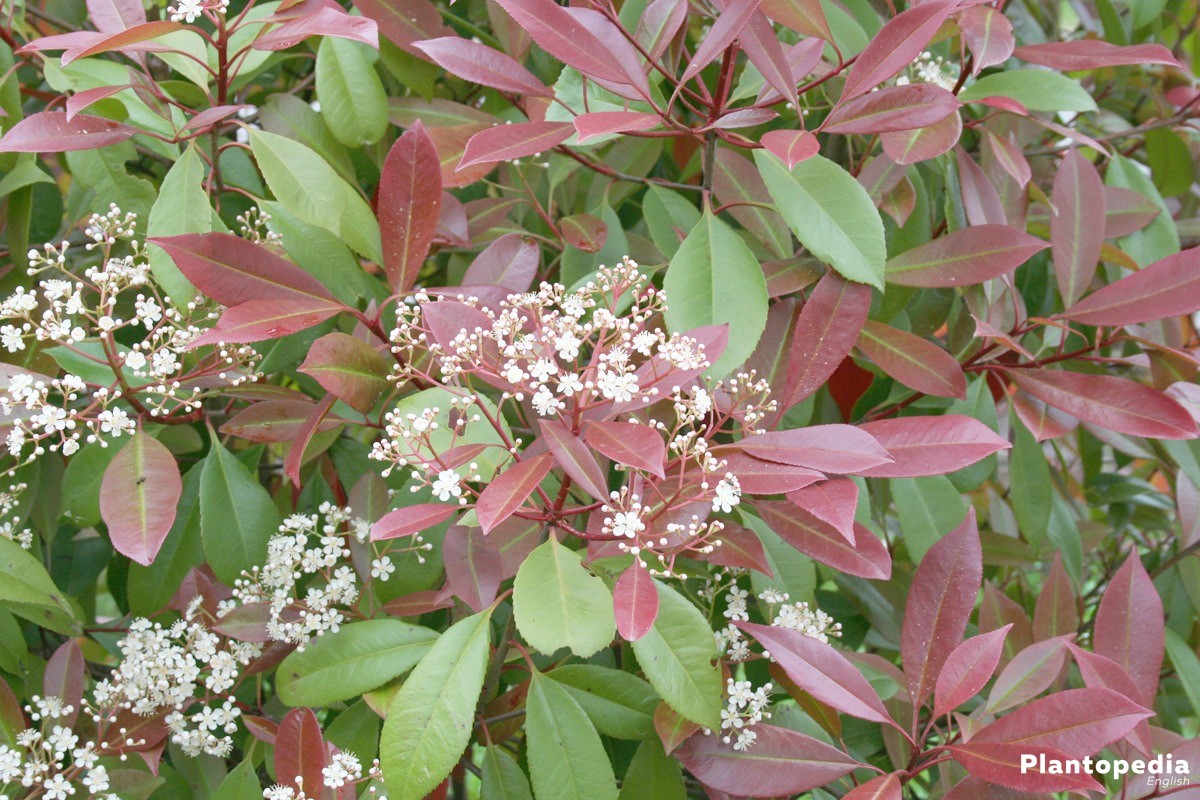
Reproduction
There are two ways of vegetative reproduction for a single-origin offspring of photinia Red Robin. In contrast to the generative sowing of seeds, you can be sure, that the attractive attributes of the hybrid are preserved when using scions and seedlings. Both methods are described in detail below.
Scions
During the months of May and July life in a photinia fraseri pulsates to the branch tips. You should use this fact for the reproduction with terminal cuttings. Since it is then time for the cutback anyway, you receive a wealth of valuable propagating material. All one-year, non-flowering, healthy shoot tips are suitable for terminal cuttings. Cut each specimen with a length of 10-15 cm off shortly below a dormant bud, as a new root system will grow from it.
This is how you proceed further:
- remove the leaves in the lower part of the shoot, including possible flower remnants
- fill small pots with peat sand or thinned standard soil
- put one scion at a time two thirds deep into the substrate and then pour
- insert two wooden sticks on the right and left to put a plastic bag over them
In the following weeks, the soil must not dry out in the half-shady, warm and protected location. Fertiliser is not used during this time. Remove the cover, as a new shoot shows up. If a vital s´root system has formed up until early autumn, plant the young photinias. Otherwise, cultivate the shrubs throughout the winter in a bright, frost-free place, until you can plant in May.
Layers
If you keep the premium variety Red Robin as a shrub in your garden, the layer-method is ideal for uncomplicated reproduction. In this case, you share the care of the offspring with the mother plant. Suitable candidates are one to two-year old shoots in the outer shrub area. Draw these to the ground, mark the point of contact and draw a furrow in the ground using a spade.
Continue in these steps:
- remove the leaves from the middle part of the layer and dig it in the furrow a few centimetres deep
- use stones or staples to fix the layer in the ground so the branch will not bounce up
- tie the shoot tip to a wooden stick
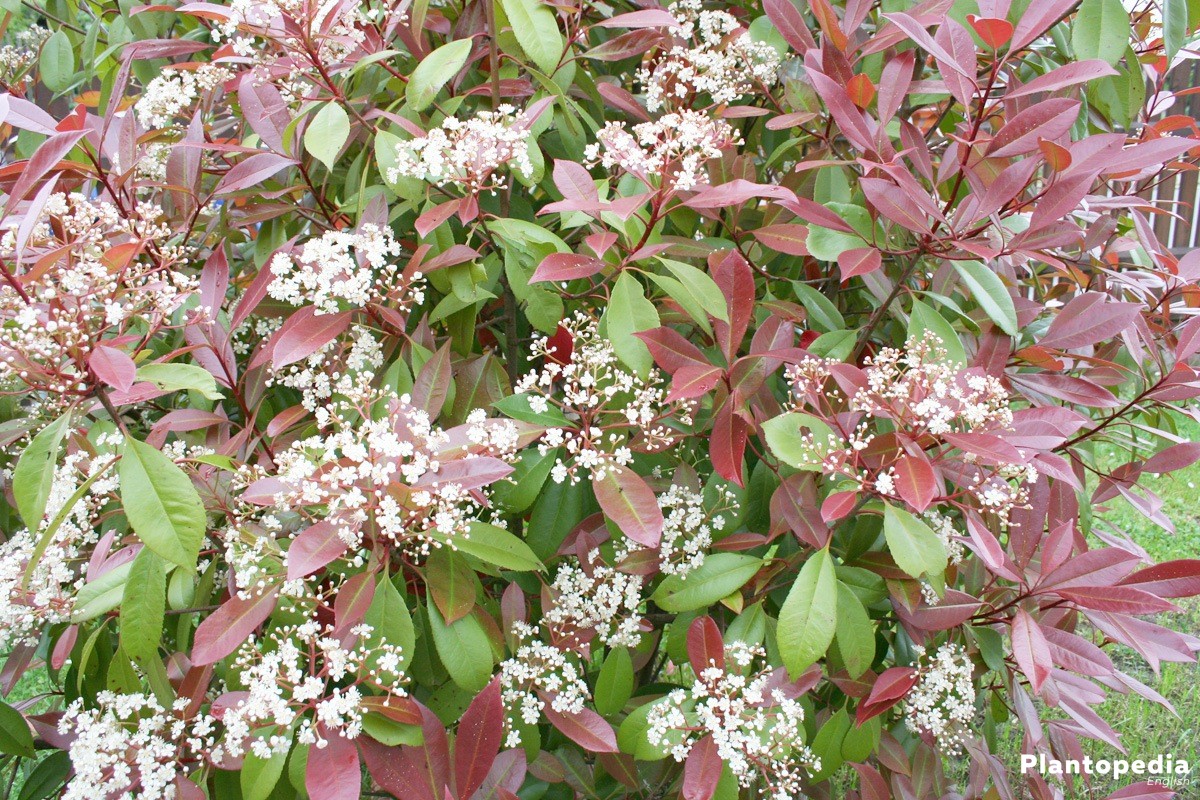
While the mother plant continues to supply the layer with nutrients, keep the soil slightly moist. During winter, cover the bed with a layer of foliage or brushwood. By the next spring, the shoot will have grown its own root system. If you feel a strong resistance when slightly pulling, the layer can be separated from the mother plant. Either feed the young photinia up in a pot until autumn with a nutrient-rich substrate or plant your pupil instantly at a sunny, warm place.
Diseases
A care appropriate to the species is rewarded with a photinia which has a high potential of resistance. Nevertheless, a photinia is not completely immune to diseases. It is mainly fungal infections which lead to health problems. Diseases like Venturia, mildew or leaf spots cause unhealthy discoloured leaves which subsequently turn browner, dry and fall off. Household remedies are not effective when there is a heavy infestation.
In order to save a Red Robin, first cut out all infected plant parts and dispose them. Then use a fungicide which is approved for use in house gardens and allotments. The Federal Office of Consumer Protection and Food Safety (BVL) runs a public database, which states all permitted plant protection products.

Pests
Among the numerous pests in the garden, there are two of the usual suspects that specifically target the Red Robin. In contrast to the infections, which are difficult to fight, there is a good chance to get rid of the plague with natural means.
Weevils (otiorhynchus)
This type of pest infests your photinia with both adult beetles and their larvae. This results in damage to the leaves and the roots which significantly affects the growth and vitality of the plant. An effective countermeasure is Nematodes. These tiny threadworms destroy the pests and you do not need to use a chemical preparation. The nematodes are applied with the watering can or a plant protection syringe.
Aphids
Aphids have it in for the splendid, bright red shoots. Therefore, keep an eye on the young leaves and check for an infestation with white, green or dark aphids every few days. They sit preferably on the bottom side of the photinia’s leaves in order to drink the sap. A classic solution with soft soaps puts an end to the plague. In addition, environmentally friendly remedies based on rapeseed oil are available in the specialist trade.

